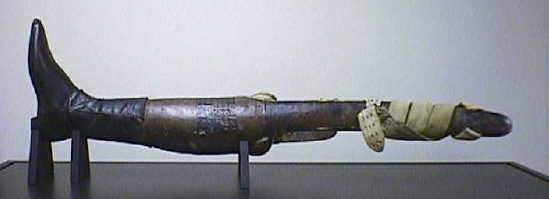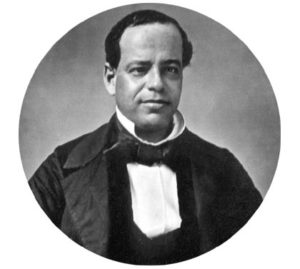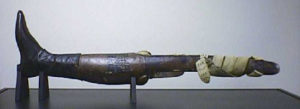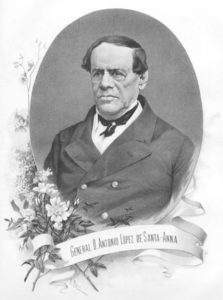Antonio Lopez de Santa Anna served 11 terms (6 official and 5 unofficial) as president of Mexico between the years of 1833-1855. For his many efforts, the cunning and self-proclaimed, “Napoleon of the West”, proved to be as charming as he was inept, cycling in and out of favor (and exile) with the Mexican people throughout his career in Mexican politics.
The War for Mexican Independence: 1821
During the Mexican War for Independence, a young Santa Anna fought in the Spanish Royalist Army where he learned the merciless atrocities of war during battles such as that which occurred in Medina, Texas in 1813, where an estimated 1300 rebels were slaughtered and executed in what is known to be the bloodiest battle ever fought on Texas soil. During the final year of the Mexican Revolution (1821), Santa Anna saw the tides turning in favor of the rebels and he opted to switch sides to support an independent Mexico. Such antics, when coupled with his highly touted charming demeanor, won him influence among citizens and politicians in Mexico City. In 1833, Santa Anna was elected president of the young Mexican Republic, marking the beginning of what became a roller-coaster career characterized by intense peaks and valleys.
The Texas Revolution: 1836
Two years into his presidency, he faced another rebellion in the Anglo colonies, one which was eventually led by Lone Star Legend, Sam Houston, and which culminated in the loss of Texas for Mexico. With intent to quell the rebellion and punish the Texian rebels, Santa Anna marched north with an army of thousands during the dead of winter in 1835, a rare season in Mexican history that saw record low temperatures and 15-16 inches of snow. His infamous victory at the Alamo might actually be viewed as a loss had the Mexican Army not killed the entirety of some 200 Texans who gave their lives holding the mission. For his efforts over the 13-day battle, Santa Anna lost 3 times the number of troops he defeated in the Alamo before splitting his army in a blundering effort to surround Sam Houston and 900 more rebels who were on the march near San Jacinto. At the most inopportune of times, the Napoleon of the West decided to take a siesta in an open field near a small lake, and opted not to post guards, a move that set the stage for his first big fall and his own Waterloo. Under surprise attack, Mexico lost the war in 18 minutes to the Texans at San Jacinto. In the heat of the strike, Santa Anna fled the scene on horseback and was found the following morning hiding in a thicket of brush. After his capture, the Mexican president attempted to conceal his identity after having swapped his general’s uniform for that of a common soldier. Once identified, he famously traded Texas to Sam Houston in exchange for his own life, triggering the first of many falls from favor within the public eye of Mexico. In proper fashion, Austin, Texas, was originally named Waterloo as a poke at Santa Anna’s self-proclaimed Napoleonic likeness.
The Pastry Wars: 1838
In 1838, Santa Anna seized an opportunity for redemption while fending off a French invasion of Mexico. He once again led Mexican troops in what became another major Mexican military loss, but negotiations between France and the Mexican government eventually settled the dispute and brought end to the invasion. Though he had notched his belt with another difficult loss on the battlefield, Santa Anna was met with renewed support from the Mexican people for his will and ability to quickly rally troops and come to the defense of the country. For his troubles during the conflict, Santa Anna managed to lose his leg to cannon fire, an incident for which he chose to hold a formal burial with full military honors for his sacrificed limb. He famously donned a wooden prosthetic after the leg was successfully amputated.
The Mexican-American War: 1846-1848
During the early 1840’s, Santa Anna once again lost the support of his people and had been exiled to Cuba around the same time Manifest Destiny had begun to cause friction between America and Mexico. By 1846, the U.S. declared war on Mexico after 11 American soldiers were killed by the Mexican Army along the Rio Grande. The war itself was one of high political controversy on the part of the United States, but once again, Santa Anna would get his chance to revive a career destined not to die. He booked passage on a boat from Cuba to Mexico, a voyage which was intercepted by the U.S. Military. Upon inspection, Santa Anna assured the U.S. government that he would go to Mexico and negotiate peace agreements to bring the war to end. Though his cunning nature preceded him, the Americans took the bait and Santa Anna returned to Mexico only to be given full command of 20,000 troops with the hope that he might be able to prevent the loss of the northern half of the Mexican national territory to the Americans. No such defense was in order, however. Santa Anna’s army was defeated at Cerro Gordo, a battle which ended somewhat satirically when the Mexican general’s chariot was raided by the 4th Regiment of the Illinois Volunteer Infantry. In yet another effort to flee from capture, Santa Anna jumped on his horse and rode away. In his frantic hurry, however, he managed to leave behind his peg-leg, which was confiscated by the Americans and became a prized war trophy for the American victory. The leg, to this day, remains on display at the Illinois State Military Museum in Springfield.
The Gadsden Purchase: 1853
After losing the northern half of its nation, Mexico once again retracted its support for their on-again-off-again leader. He was again sent into exile – this time to Jamaica – and as had been seen before would again return and become the president of Mexico. In 1853, a resurgence of conservative efforts brought Santa Anna back into power. Upon his arrival back into office, he found that the government was in dire need of cash if it hoped to maintain a military. After much negotiation and in the interest of raising federal funds, Santa Anna accepted a $10 million dollar offer from the U.S. in exchange for a nearly 30,000 square mile tract of land which served as the final puzzle piece in completing the expansion of the American southwest.
From Staten Island to Chewing Gum: 1855
In 1855, after falling from grace in the Mexican public for his last time, Santa Anna was exiled to Staten Island where, in a roundabout way, he became acquainted with an inventor by the name of Thomas Adams. At the time, Santa Anna had been importing a chewy, rubbery substance harvested from Mexican sapodilla trees. Adams was intrigued and hoped to use the substance in order to find a way to produce a rubber substitute. Santa Anna, still holding onto dreams of a return to power, saw an opportunity to finance his return to Mexico. The project, however, failed after a $30,000 effort. Adams did, somewhat ironically, manage to find a way to add a combination of flavor and sweeteners to the plant, which led him to produce what he referred to as, “rubber chewing gum.” Adams went on to brand a chewing gum company that would become the largest in the country, later eclipsed only by Wrigley’s and Chiclets. Santa Anna, though he would eventually return to Mexico City, never reclaimed his power in politics, and lived to be 82 years old before dying of natural causes.
The life and career of Antonio Lopez de Santa Anna is nothing shy of a story worth telling, but moreover, might be better used as a didactic tale serving to warn citizens of the potential folly which can result from pouring public trust, support, and votes into leaders who simply look and speak in manners that are attractive.
Related article: “Sand, Smugglers, and Santa Anna Helped Name Flour Bluff”



